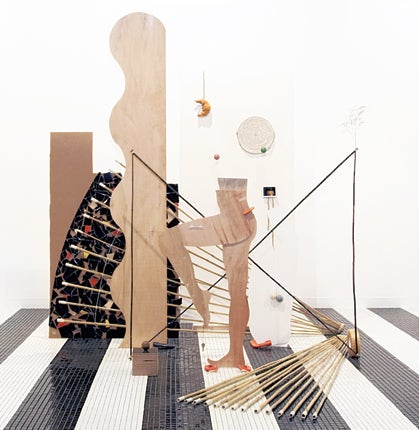Newspeak: British Art Now, Part 2, Saatchi Gallery, London

As one might expect from Charles Saatchi, this exhibition begins with a funny, immediate work. Ansel Krut's painting, of an upturned saucepan full of sausages, is painted in drab dirtyish shades of paint that look creepily crusty, as though the painting has been found at the back of a garage somewhere. This is a good example of the work on show in Newspeak. You see something familiar turned on its head, and you don't need a press release or a wall text to understand it.
As refreshing as this can be, in some respects, it often backfires. Painting and sculpture dominate overwhelmingly, and much of the painting in this edition of the show is unremarkable: rather messy, expressionistic, yet figurative stuff. Several sculptures, too, just appear to be thin, empty jokes. Alexander Hoda's assemblages of junk covered in rubber, so that they look like copulating creatures, for example, leave me cold. However, the strong work stands apart, and demands that you look at it for longer. Anthea Hamilton's sculptures, employing a variety of materials, are some of the best, pulling out the strangeness of the objects seen in cubist paintings and making them appear exciting, yet deranged. Anna Barriball's graphite-on-paper rubbing of an ordinary interior door is dark and crumpled and broods with a kind of ominous glamour.
However, the curating is basic and clunky. Barriball's door is placed in a room full of works tied together by nothing more than the fact that they are all black and white. There's a room with a "faces" theme; abstract, angular fluorescent shapes are layered with dark drips in Luke Rudolf's paintings, in which one can only just make out eyes, mouths and shoulders, and these are matched with Caroline Achaintre's faces made of handmade wool carpet, alongside other "portrait" works. It's a little tiresome and uninspired as a way of thinking about the art of the present day. Even these broad strokes are not adhered to, however. Take a room that appears to gather together several types of misty, smoky paintings, including Maike Schoorel's barely there canvases of gleaming white paint with light spots and smudges of pale colour in which one can discern hazy figures. In the corner of the room, incongruously, there's a large Des Hughes sculpture that looks like a rusting knight lying on a tomb. It doesn't really fit but it just looks as though someone has said: "Ah well, it doesn't matter if it's not a misty painting, just stick it in the corner."
Saatchi pretty well refuses to include video work in his surveys of art. For this alone, one can say that he is radically out of step with the times. Many of the important themes of recent art in Britain are ignored and most of the artwork here is quieter and more referential than the shouting, sensational shocks that we came to expect from Saatchi's collection of YBAs. Though the gallery is large, airy and spacious, the vision is far too narrow. If you want to see an exhibition that defines current art practice in Britain, I feel pretty confident to assure you that this is not it.
To 17 April (www.saatchi-gallery.co.uk)
Join our commenting forum
Join thought-provoking conversations, follow other Independent readers and see their replies
Comments
Bookmark popover
Removed from bookmarks